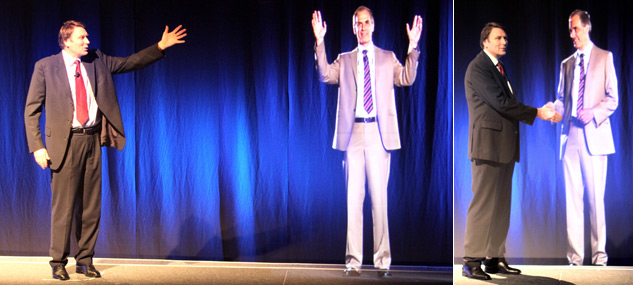
Telecommuting … Dr Hugh Bradlow appearing in Adelaide as a live hologram, and right, shaking hands with an executive / AAP
In an Australian first, Dr Bradlow’s life-sized, real-time hologram walked, talked and interacted with business executives at an Adelaide conference while he stood in front of cameras in Telstra’s Melbourne office.
Cameras and microphones in Adelaide allowed Dr Bradlow to see and hear his subjects from 725kms away as his audience watched his high definition image projected onto a transparent screen or “foil”.
The technology created by British company Musion Eyeliner has already enabled former US vice president Al Gore to speak to the Live Earth concert’s London audience from Tokyo and retailer Target to host a model-less virtual fashion show in New York last year.
UK band Gorillaz has also used Musion to give life to three-dimensional cartoon characters who performed their song at a 2005 MTV Awards concert in Portugal as rappers interacted with them live on stage.
But it’s not just for entertainment value, said Telstra enterprise and government group managing director David Thodey who shook “airhands” with Dr Bradlow during the function.
There are real applications for this “gee whiz” technology, he said.
He said companies wanting to reduce carbon emissions could replace business flights with live broadcasts.
Applications would also benefit health and education sectors.
“If you’re in the US and can’t attend a conference you could save many hours flying time in that sense to give presentations,” he said.
“We’ve all seen this sort of thing in futuristic sci-fi movies, but the reality is that it can be done here and now, as we have just demonstrated.”
He said the high definition holographic video projection system took about half a day to set up.
The infrastructure needed was “tens of megabytes” to support a life-sized figure – less was needed to project a smaller figure.
Supporting the high-speed data feed was Telstra’s internet-based Next IP network which was launched in April last year.
The network took 18 months and $1.5 billion to replace a number of legacy networks and can be coupled with its 3G wireless network to use phone, computer and other communications devices on one common system.
By Meredith Booth
May 27, 2008 12:45pm
Source: News.com.au